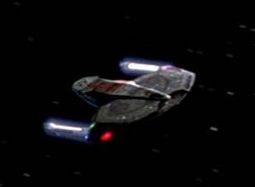Saber class (LUG)
| Date Entered Service | 2370[1] |
| Length | 160m[1][2] / 364.77m[3] |
| Width | 111.8m[2] / 225.61m[3] |
| Height | 82.6m[2] / 52.48m[3] |
| Decks | 6[1][2] |
| Mass | 310,000mt[3] |
| Transporters | • Personnel: 2[1] • Emergency: 2[1] • Cargo: 2[1] |
| Shuttlecraft | 6[2] |
| Crew | 40[3] |
| Passengers | 80[1] |
| Evacuation Limit | 200[3] |
| Velocity | • Crusing: Warp 5[1] • Maximum Safe: Warp 9.2[1] • Emergency: Warp 9.7 for 12 hours[3] |
| Weapons | • 4 Type X Phaser arrays[3] • 2 torpedo launchers[3] • 100[1] Type III[2] Photon torpedoes[3] |
The fourth class authorized by Starfleet's Perimeter Defense Directive (PDD), the Saber class of light cruisers quickly saw extensive action on several frontiers. Using materials technology and spaceframe elements borrowed from the Advanced Starship Design Bureau (ASDB) Defiant Development Project, the first Saber class vessels were commissioned in late 2370 as fast perimeter defense ships.[1]
Saber class light cruisers quickly proved that they could hold their own against much larger opponents. The internal nacelle configuration, inspired by Cardassian embedded-warp technology and explored by Starfleet R&D during the Defiant Project, made the ship a compact target and saved space that would otherwise have been required for nacelle field conduits and containment structures,[1] although this made the class more vulnerable to core breaches when full armor penetration occurred.[2]
Small and designed for easy mass production, no less than five major yard facilities,[1] including the Advanced Starship Design Bureau Integration Section at the Earth Spacedock,[3] produced Saber class vessels[1] by the end of the Dominion War.[2] As a result, within five years of the U.S.S. Saber's commissioning, there were already more Saber class ships in active service than any of the other new classes that resulted from the PDD.[1]
Saber class vessels proved particularly effective in convoy escort, sector patrol, intelligence reconnaisance, and commerce interdiction missions. Following the Dominion War, Saber class vessels often became "troubleshooters:" fast, efficient ships that could investigate problems anywhere in the Federation and have a good chance of solving them, or of surviving and reporting back. Many promising Dominion War veterans were given peacetime Saber class commands as a way of grooming them for larger ships, while keeping these veteran personnel as close to the sharp end as possible.[2]
Saber class vessels
Prime Timeline
U.S.S. Saber • U.S.S. Yeager NCC-61947
Columbia Timeline
U.S.S. Saber • U.S.S. Yeager NCC-61947
First Splinter Timeline
U.S.S. Borealis NCC-62587 • U.S.S. da Vinci NCC-81623 • U.S.S. Garza NCC-61813 • U.S.S. Peterson NCC-61815 • U.S.S. Saber • U.S.S. Sanders NCC-61822 • U.S.S. Sentry NCC-61890 • U.S.S. Yeager NCC-61947
LUG Timeline
U.S.S. Arian • U.S.S. Chaka • U.S.S. Denmark • U.S.S. Dosalnar • U.S.S. Falchion • U.S.S. Gagarin • U.S.S. Hrisal • U.S.S. Kal'Hris • U.S.S. Larue • U.S.S. Lu'ghara • U.S.S. Luxembourg • U.S.S. Saber • U.S.S. Schirra • U.S.S. Shepard • U.S.S. Storta • U.S.S. Triumph • U.S.S. Veldar • U.S.S. Yeager NCC-61947
STO Timeline
U.S.S. da Vinci NCC-81623 • U.S.S. Saber NCC-61900 • U.S.S. Yeager NCC-61947
Notes and References
- ↑ Jump up to: 1.00 1.01 1.02 1.03 1.04 1.05 1.06 1.07 1.08 1.09 1.10 1.11 1.12 1.13 1.14 Isaacs, Ross A. (Line Developer). The Price of Freedom: The United Federation of Planets Sourcebook. Star Trek: The Next Generation Roleplaying Game. Book 25100 . Written by Brian Campbell, Heather Curatola, Harry Heckel, Kenneth A. Hite, Ross A. Isaacs, Steve Long, Christian Moore, Nicky Rea, Aaron Rosenberg, John Snead, and Ray Winninger. Original art by Bryan Gibson. Last Unicorn Games, Inc.. February 1999.
- ↑ Jump up to: 2.0 2.1 2.2 2.3 2.4 2.5 2.6 2.7 2.8 Heinig, Jess (Line Developer). Starfleet Operations Manual. Star Trek Roleplaying Game. Book 3 . Written by Kenneth Hite. Original Art by C. Brent Ferguson and David Pipgras. Decipher, Inc.. 2003.
- ↑ Jump up to: 3.00 3.01 3.02 3.03 3.04 3.05 3.06 3.07 3.08 3.09 3.10 Zimmerman, Herman et al (Authors). Star Trek: Deep Space Nine Technical Manual. Star Trek: Deep Space Nine. Book. Pocket Books. 1998.
